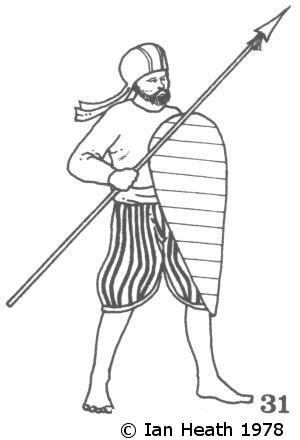
Create an Amazon Business Account
FATIMID INFANTRYMAN c. 1150
[based on a Fatimid Manuscript Fragment from Fustat, 12th Century.]An extract from Armies and Enemies of the Crusades 1096-1291
by Ian Heath



31. FATIMID INFANTRYMAN c. 1150
This figure and the next come from a ms. fragment from Fustat which depicts Moslems and Christians in battle before a fortress. It probably dates to c. 1150 but may be somewhat earlier, so the Moslem warriors depicted are fairly certainly Fatimids.
This figure is barefoot, armed only with shield and fringed spear, and wears an unusual pair of what are apparently baggy breeches, perhaps the skirt of his tunic pulled up through a belt. The kite-shield was called Tariqa by the Moslems, a term which, it has been suggested (curiously), evolved from the name of the small, circular European shield, the Targe; this seems improbable. The Tariqa was possibly even adopted prior to the Crusades (there are kite-shields carved on the Bab al-Nasr) but certainly during the Crusades Tariqas would have become available in far larger numbers, shields - together with other Frankish equipment - being recorded to have been reused by the Moslems after capture from the Franks; al-Qalanisi, referring to the equipment of Nur ed-Din’s troops in 1157, specifically speaks of ‘Frankish’ Tariqas. The Tariqa appears to have become popular as far east as Persia (see 50 and 87) but dropped out of use in Syria during the Bahriyyah Mamluk era, though al-Maqrizi still records a unit of young Mamluks equipped with Tariqas.
Ibn al-Athir actually records archers in Saladin’s army with Tariqas, and al-Tartusi’s Tabsirah describes the Tariqa in detail. He records it as ‘the shield used by the Franks and Byzantines, which is shaped like an onion and painted in all sorts of colours, designs and artistic patterns. It is a long shield of a shape acceptable to both the horseman and the foot-soldier; it begins round (at the top), but narrows down little by little and at the bottom ends in a sharp point like the tip of a spear’. A variant of the Tariqa was the Januwiya, described as like a Tariqa but with a flattened base so that infantry in a defensive formation could stand their shields before them.
A second Moslem infantryman in the source appears to wear the same ‘breeches’ but is bareheaded and wears short, black ankle-boots. Neither wear Tiraz bands.